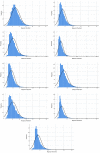Identifying Ability and Nonability Groups: Incorporating Response Times Using Mixture Modeling
- PMID: 36325120
- PMCID: PMC9619323
- DOI: 10.1177/00131644211072833
Identifying Ability and Nonability Groups: Incorporating Response Times Using Mixture Modeling
Abstract
The goal of the present study was to address the analytical complexity of incorporating responses and response times through applying the Jeon and De Boeck mixture item response theory model in Mplus 8.7. Using both simulated and real data, we attempt to identify subgroups of responders that are rapid guessers or engage knowledge retrieval strategies. When applying the mixture model to a measure of contextual error in linguistics results pointed to the presence of a knowledge retrieval strategy. That is, a participant either knows the content (morphology, grammar rules) and can identify the error, or lacks the requisite knowledge and cannot benefit from spending more time on an item. In contrast, as item difficulty progressed, the high-ability group utilized the additional time to make informed guesses. The methodology is illustrated using annotated code in Mplus 8.7.
Keywords: IRT; Mplus; guessing; knowledge retrieval; response time.
© The Author(s) 2022.
Conflict of interest statement
The authors declared no potential conflicts of interest with respect to the research, authorship, and/or publication of this article.
Figures





References
-
- Anderson D. R. (2008). Model based inference in the life sciences. Springer.
-
- Bockenholt U., Albert D., Aschenbrenner M., Schmalhofer F. (1991). The effects of attractiveness, dominance, and attribute differences on information acquisition in multiattribute binary choice. Organizational Behavior and Human Decision Processes, 49, 258–281.
-
- Bolsinova M., Tijmstra J. (2018). Improving precision of ability estimation: Getting more from response times. British Journal of Mathematical and Statistical Psychology, 71, 13–38. - PubMed
-
- Boughton K., Smith J., Ren H. (2017). Using response time data to detect compromised items and/or people. In Cizek G. J., Wollack J. A. (Eds.), Handbook of detecting cheating on tests (pp. 177–190). Routledge.
-
- Chen W.-H., Thissen D. (1997). Local dependence indices for item pairs using item response theory. Journal of Educational and Behavioral Statistics, 22, 265–289.
LinkOut - more resources
Full Text Sources
